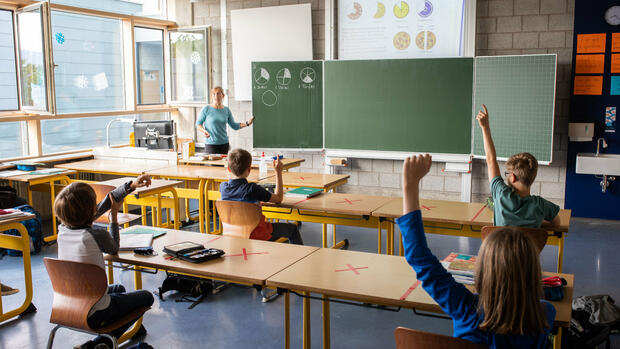The shortage of teachers is one of the biggest problems in German schools.
(Photo: dpa)
Berlin The federal states report that there is currently a shortage of around 12,000 teachers at German schools. The shortage could be significantly smaller if the study conditions made it easier to start a career, as a new analysis suggests.
Between 2017 and 2021, an average of a good 52,000 first-year students began a teacher training course, but only around 28,300 prospective teachers completed a traineeship during the same period. This cannot cover the demand for new teachers, around 35,000 new appointments per year would be necessary. This is shown by an evaluation by the Stifterverband, the organization for promoting science through industry.
>> Read also: Experts expect teacher shortages to continue for another 20 years
These hurdles in the course of studies urgently need to be removed in order to prevent an “educational emergency” that has “serious consequences for our future viability and competitiveness and our social prosperity”, warns the Stifterverband team led by university expert Bettina Jorzik.
There are young people who change courses in the course of their studies to a similar extent in other courses. But there, the loss is compensated to a much greater extent by changers. However, this often prevents the rule that educators have to study two subjects in teacher training courses. “A one-subject teacher training course could help here,” advises Jorzik. The great shortage of staff is now allowing Brandenburg at least to examine this option for the first time.
Teacher training: too few graduates start a traineeship
The scientific commission of the Ministers of Education had recently recommended drastic measures because of the shortage of teachers: Above all, the high part-time rate would have to be reduced, the number of hours per week increased and classes enlarged. This has met with massive criticism from teachers.
A second hurdle for prospective teachers is the traineeship: Every year, 29,400 people start the so-called preparatory service after completing their teacher training course – too few to cover the demand. In addition, there are only 1,200 university graduates who begin their legal clerkship without a teaching degree, i.e. so-called lateral entrants. Access must be made much easier for them, the Stifterverband demands.
Because after that, the schools only have lateral entrants left to fill the gaps, i.e. academics who have neither studied teaching nor completed a traineeship, but usually switch to school from other professions. But in view of the shortage of personnel, this path must also be made easier, according to the Stifterverband.
The group of lateral entrants has become increasingly important as a source of personnel in recent years. However, their brief pedagogical training in many countries is often criticized.
In Saxony-Anhalt, the coalition of the CDU, SPD and FDP has just lowered the requirements even further: now, for the first time, non-academics can also apply for a teaching job in secondary schools. The prerequisite is a qualification at level 6 of the German qualification framework, i.e. master craftsman or specialist.
Education Minister Eva Feußner (CDU) also sees this as an opportunity: “By recruiting people who are new to the profession, we are actively promoting practical and real-life-oriented preparation for the children for their life after school.” Looking for teachers from abroad and lateral entrants to be hired in the teaching profession. However, the GEW teachers’ union hopes that non-academic teachers will remain the exception and is pushing for a mandatory training program.
Controversy over overtime for teachers
Saxony-Anhalt, where the shortage of teachers is particularly serious, was the first state to increase the teaching time of teachers for the coming school year: From autumn, primary school teachers will have to spend 28 instead of 27 hours in front of the class, and secondary school and high school teachers will have to spend 26 instead of 25 hours in front of the class. There were also initial considerations in other countries, but so far the ministers of education have shyed away from this step.
One reason may be the legal dispute from 2015 in Lower Saxony: At that time, the state had increased the teaching time of high school teachers by one hour a week. However, this failed at the Higher Regional Court. The judges rejected the increase in working hours because the country could not provide any empirical knowledge of the actual total working hours of teachers. The GEW Sachsen-Anhalt announced that it would also take legal action against the state’s decision.
More: The educational level of Germans is declining

